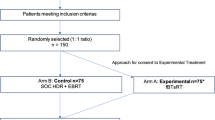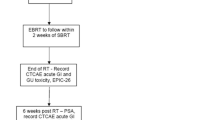Purpose:
Experiences with a new high-dose-rate brachytherapy (HDR-BT) boost technique in 41 patients with stage T3b prostate cancer are presented.
Patients and Methods:
The patients received 18 Gy of HDR-BT (9 Gy on days 1 + 8) plus 50.4 Gy of EBRT. 20 patients (group A) had BT applicators placed into the prostate alone resulting in 18 Gy to prostate and 0 Gy (tip) to 12 Gy (base) to seminal vesicles (SV). The cumulative EQD2 (equivalent dose in 2-Gy fractions, α/β 1.5 Gy) to the SV was 47.5-73.3 Gy. 21 patients (group B) had BT applicators placed into both prostate and SV resulting in 18 Gy to prostate and to > 80% (but not 100%) of the SV (cumulative EQD2 81.5-101.5 Gy). Both groups were compared for acute and late toxicity and for biochemical relapse-free survival (bRFS).
Results:
The 3-year bRFS was 57% for group A and 79% for group B patients (p = 0.29). A grade 3 acute toxicity (CTC 2.0) was not observed. Grade 2 acute toxicity (proctitis, cystitis, skin toxicity) was comparable in both groups. A grade 3 late toxicity did not occur. Impotence rates were 35% in group A and 24% in group B, respectively (p = 0.73).
Conclusion:
The new HDR-BT technique (group B) was associated only with minor acute and late toxicity and appears to result in better bRFS than the conventional HDR-BT technique (group A). The results must be confirmed in a prospective trial.
Ziel:
Erfahrungen mit einer neuen High-Dose-Rate-Brachytherapie-(HDR-BT-)Boost-Technik bei 41 Patienten mit T3b-Prostatakarzinom (Tabelle 1) werden präsentiert.
Patienten und Methodik:
Die Patienten erhielten 18 Gy HDR-BT (9 Gy an Tag 1 + 8) plus 50,4 Gy perkutan. Bei 20 Patienten (Gruppe A) wurden BT-Applikatoren nur in der Prostata platziert. Die Dosis betrug 18 Gy in der Prostata sowie 0 Gy (Spitze) bis 12 Gy (Basis) in den Samenblasen (SB). Die kumulative EQD2 („equivalent dose in 2-Gy fractions“, α/β 1,5 Gy) betrug in den SB 47,5-73,3 Gy (Abbildung 2). Bei 21 Patienten (Gruppe B) wurden BT-Applikatoren in der Prostata und den SB platziert (Abbildung 1). Die Dosis in Prostata und > 80% (aber nicht 100%) der SB betrug 18 Gy (kumulative EQD2 81,5-101,5 Gy; Abbildung 2). Die Gruppen wurden hinsichtlich Akut- und Spättoxizität sowie des biochemischen rezidivfreien Überlebens (bRFS) verglichen.
Ergebnisse:
Das bRFS nach 3 Jahren betrug 57% in Gruppe A und 79% in Gruppe (p = 0,29; Abbildung 3). Eine Grad-3-Akuttoxizität (CTC 2.0) wurde in beiden Gruppen nicht beobachtet. Die Grad-2-Akuttoxizität (Proktitis, Zystitis, Hauttoxizität) war in beiden Gruppen vergleichbar (Abbildung 4). Eine Grad-3-Spättoxizität trat bei keinem Patienten auf. Die Impotenzraten betrugen 35% in Gruppe A und 24% in Gruppe B (p = 0,73).
Schlussfolgerung:
Die neue HDR-BT-Technik (Gruppe B) ist gut verträglich und scheint mit einem besseren bRFS einherzugehen als die konventionelle HDR-BT-Technik (Gruppe A). Die Ergebnisse müssen in einer prospektiven Studie überprüft werden.
Similar content being viewed by others
Author information
Authors and Affiliations
Corresponding author
Rights and permissions
About this article
Cite this article
Rades, D., Schwarz, R., Todorovic, M. et al. Experiences with a New High-Dose-Rate Brachytherapy (HDR-BT) Boost Technique for T3b Prostate Cancer. Strahlenther Onkol 183, 398–402 (2007). https://doi.org/10.1007/s00066-007-1643-z
Received:
Accepted:
Issue Date:
DOI: https://doi.org/10.1007/s00066-007-1643-z




